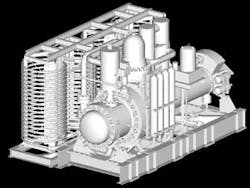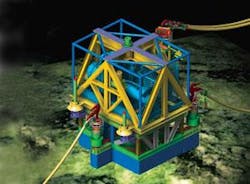Petrobras sets pace for artificial lift and fluid flow research
Dayse Abrantes
Peter Howard Wertheim
Brazil’s Petroleo Brasileiro SA is prepared to set an important milestone for deepwater and ultra-deepwater petroleum production. The company is pioneering a technological application on artificial lift and fluid flow.
The final testing of a complete system for subsea deployment called SBMS-500, an acronym with the Portuguese words for subsea multiphase pumping system, will take place by the end of the year in the giant Marlim field in the Campos basin offshore Rio de Janeiro state.
The system
The SBMS-500 deepwater system is based on an adjustable speed electrically driven twin-screw pump, Dr. Elísio Caetano, senior consultant and coordinator of the SBMS-500 project, says.
The pump is a positive displacement device capable of “pumping” gas (with a wide range of void fractions and viscosity values) and liquid (equally with a wide range of densities and viscosity values, particularly high value ones) together. The pump can also handle middle to high head, usually referred as differential pressure values.
According to Caetano, SBMS-500’s features include 500 cu m/hr of total flow capacity, which equates to 75,000 b/d, a 60-bar pressure increment and operation under gas volumetric fractions (GVF) up to 95% v/v. Proper materials usage also allows operation compliance with fluids that are either aggressively corrosive and/or abrasive, Caetano says.
The robust equipment is a result of more than 12 years of research and was developed through international technological agreements. Its several-years-long development testing phase was conducted at Petrobras’ Experimentation Nucleus (NUEx), Engineer José Otávio do Amaral Baruzzi at Atalaia Velha, near Aracaju, the capital of Sergipe state. Engineers specially developed and constructed a test site at NUEx for multiphase equipment development at the company’s northeast fluids production and processing hub.
Capabilities
This new hybrid equipment can supply energy to fluids of various kinds and different densities. Once it is installed at some point in the flowlines on the seafloor, it propels the produced well flow mixture to platforms or to onshore installations. The new field test scheduled by Petrobras for a system installed on the seafloor will produce from the Marlim-10 well (MRL-10) to the P-20 platform.
“The SBMS-500 promotes the direct transfer of energy to a multiphase mixture (oil, gas and water), allowing transport to longer distances and increased flow rate. It is seen as a solution for the development of deep and ultra-deepwater fields where reservoirs are marginal in profitability or present flow assurance issues such as viscous oils (prone to emulsion formation), organic deposition, and/or gas hydrate,” Caetano says.
In reality, the SBMS-500 is not standard equipment, considering that it is neither a pump nor a compressor, but hybrid hydraulic equipment, says Dr. Caetano.
“We believe in the spread out of the twin-screw multiphase pump usage due to high operational availability levels shown on onshore and offshore topside installations tested by several companies, including Petrobras. We are ready to prove the benefits of its application in deep waters,” Caetano says.
Cooperate agreements
Petrobras provided technical specifications and signed technological agreements with Westinghouse (now Curtiss-Wright), a manufacturer of electrical equipment, and Leistritz AG, a German manufacturer of screw type pumps.
Westinghouse developed the hermetically sealed motor and was also responsible for integrating the variable frequency drive (VFD), electrical motor and multiphase pump, while Leistritz supplied the pump. Petrobras signed additional cooperation agreements for the development of supporting systems.
Research and development costs approach $65 million. Because Petrobras led the research project, the company has the right to royalties for sales to other companies and to special prices in future acquisitions. According to Caetano, Curtiss Wright and Leistritz will own the patent for the motor-pump subsystem equipment.
Multiphase pumping
Petrobas has approved multiphase pumping for onshore and on the deck of offshore platforms and has used it with excellent results, Caetano says. The next step is putting multiphase pumps to work on the seafloor, first in Marlim field at 760 m water depth and later at depths beyond 1,000 m.
The semisubmersibleP-18 platform anchored in 910 m water depth in the Marlim field hosts the latest multiphase application on topside decks. The P-18 processes oil, associated gas, and water from 17 subsea satellite production wells.
“This system will be basically composed of the multiphase pump itself, a downstream three-phase gravitational separator, a re-circulation liquid (water) line, and a heat exchanger to keep under temperature control the re-circulating water stream, ultimately keeping the multiphase pump suction temperature under control near 70° C. The extra amount of separated water as well the hydrocarbon condensate are sent to the plant draining system for proper handling, while the separated gas is sent to the low-pressure gas scrubbers and ultimately reaches the lift gas and/or export gas compressors,” Caetano says.
Today, theP-22 platform in the Moreia field and the P-12 platform in the Linguado field in the Campos basin have multiphase pumps installed in their topside facilities. The equipment resulted in a reduction in onboard equipment, decreased energy demand, reduced gas flaring, and a lower operating noise level.
Pump model L4HK 256-82 operated from March 1999 to April 2002, accumulating 24,000 hours of operation on theP-22, anchored in 115 m water depth 90 km offshore São Tome cape.
The major objective of this multiphase installation was to reduce compulsory gas flaring, allowing export of 57,000 cm/d through the existent liquid export pipeline to the Pargo field platform (PPG-1), where the gas was again separated from the liquid and finally exported to shore as a separated gas.
In August and September 2002, the first and second multiphase pumps, model L4MK 144-96, began operation on platformP-12, which lies in the Linguado field in the Campos basin 90 km offshore, is anchored in 104 m water depth. The platform produces oil, associated gas, and water from 3 subsea production manifolds. This pair of multiphase pumps is still under uninterrupted operation, having provided 100% of operational availability and accumulating more than 20,000 running hours.
New technology,potential benefits
The life span of the SBMS-500 subsea application is 20 years under adequate maintenance and operational procedures. If wells are in condition to produce, maintenance work does not imply total interruption of production.
Caetano believes that among expected results, the multiphase pumping system should almost double the MRL-10 well production to theP-20 platform.
The subsea multiphase pumping system can be understood as an artificial and additional source of energy added to the natural one provided by the reservoir, Caetano explains. The synergic combination of these two sources naturally allows a faster production of fluids.
An extra source of energy, the subsea multiphase pumping system could enable production in greater water depths and in offsets that would either not produce or would produce under uneconomical basis, he says.
While the recovery factor is a function of the reservoir and its production rate, the subsea system can in principle lead to longer production (lower well abandonment pressure) and to the recovery of larger volumes of oil, when compared with traditional lift technologies.
Also, in gathering systems involving well flow lines and/or trunk lines (i.e. from manifolds), it is typical to use a strong segregation and/or the application of extensive choking actions to reach a stable and desired overall flow rate from several distinct sources.
Subsea multiphase pumping will expand the industry’s options when making use of gathering lines and even technically allowing a positive choking approach, Caetano says.•


